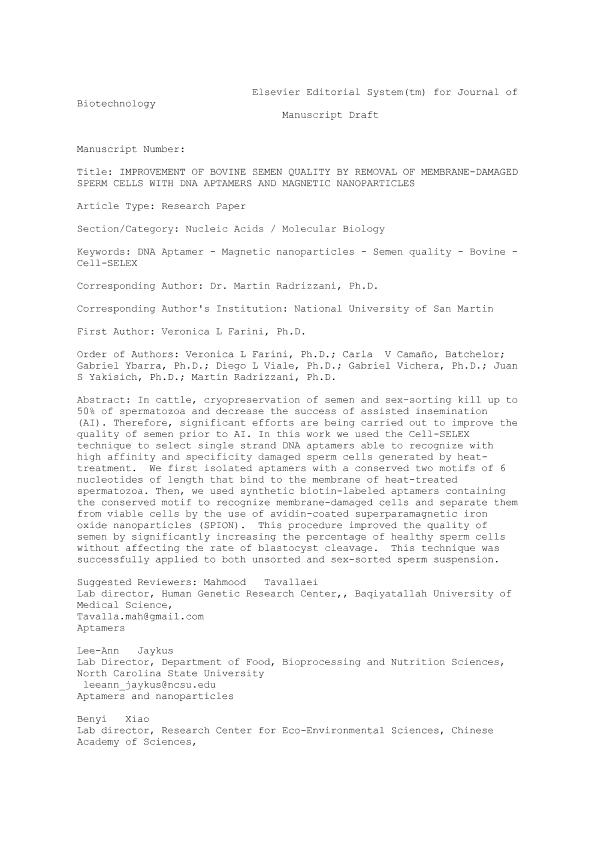Mostrar el registro sencillo del ítem
dc.contributor.author
Farini, Veronica Lujan

dc.contributor.author
Camaño, Carla V.
dc.contributor.author
Ybarra, Gabriel Omar

dc.contributor.author
Viale, Diego Luis

dc.contributor.author
Vichera, Gabriel Damian

dc.contributor.author
Yakisich, Juan Sebastian

dc.contributor.author
Radrizzani Helguera, Martin

dc.date.available
2018-05-31T14:52:10Z
dc.date.issued
2016-07
dc.identifier.citation
Farini, Veronica Lujan; Camaño, Carla V.; Ybarra, Gabriel Omar; Viale, Diego Luis; Vichera, Gabriel Damian; et al.; Improvement of bovine semen quality by removal of membrane-damaged sperm cells with DNA aptamers and magnetic nanoparticles; Elsevier Science; Journal of Biotechnology; 229; 7-2016; 33-41
dc.identifier.issn
0168-1656
dc.identifier.uri
http://hdl.handle.net/11336/46797
dc.description.abstract
In cattle, cryopreservation of semen and sex-sorting kill up to 50% of spermatozoa and decrease the success of assisted insemination (AI). Therefore, significant efforts are being carried out to improve the quality of semen prior to AI. In this work we used the Cell-SELEX technique to select single strand DNA aptamers able to recognize with high affinity and specificity damaged sperm cells generated by heat- treatment. We first isolated aptamers with a conserved two motifs of 6 nucleotides of length that bind to the membrane of heat-treated spermatozoa. Then, we used synthetic biotin-labeled aptamers containing the conserved motif to recognize membrane-damaged cells and separate them from viable cells by the use of avidin-coated superparamagnetic iron oxide nanoparticles (SPION). This procedure improved the quality of semen by significantly increasing the percentage of healthy sperm cells without affecting the rate of blastocyst cleavage. This technique was successfully applied to both unsorted and sex-sorted sperm suspension.
dc.format
application/pdf
dc.language.iso
eng
dc.publisher
Elsevier Science

dc.rights
info:eu-repo/semantics/openAccess
dc.rights.uri
https://creativecommons.org/licenses/by-nc-sa/2.5/ar/
dc.subject
Dna Aptamer
dc.subject
Magnetic Nanoparticles
dc.subject
Semen Quality
dc.subject
Bovine
dc.subject
Cell-Selex
dc.subject.classification
Otras Biotecnología Agropecuaria

dc.subject.classification
Biotecnología Agropecuaria

dc.subject.classification
CIENCIAS AGRÍCOLAS

dc.subject.classification
Otras Biotecnología Agropecuaria

dc.subject.classification
Biotecnología Agropecuaria

dc.subject.classification
CIENCIAS AGRÍCOLAS

dc.title
Improvement of bovine semen quality by removal of membrane-damaged sperm cells with DNA aptamers and magnetic nanoparticles
dc.type
info:eu-repo/semantics/article
dc.type
info:ar-repo/semantics/artículo
dc.type
info:eu-repo/semantics/publishedVersion
dc.date.updated
2018-05-30T18:26:42Z
dc.journal.volume
229
dc.journal.pagination
33-41
dc.journal.pais
Países Bajos

dc.journal.ciudad
Amsterdam
dc.description.fil
Fil: Farini, Veronica Lujan. Universidad Nacional de San Martín. Escuela de Ciencia y Tecnología; Argentina
dc.description.fil
Fil: Camaño, Carla V.. Instituto Nacional de Tecnología Industrial; Argentina
dc.description.fil
Fil: Ybarra, Gabriel Omar. Instituto Nacional de Tecnología Industrial; Argentina
dc.description.fil
Fil: Viale, Diego Luis. Universidad Nacional de San Martín. Escuela de Ciencia y Tecnología; Argentina
dc.description.fil
Fil: Vichera, Gabriel Damian. Consejo Nacional de Investigaciones Científicas y Técnicas; Argentina. Universidad Nacional de San Martín. Escuela de Ciencia y Tecnología; Argentina
dc.description.fil
Fil: Yakisich, Juan Sebastian. Hampton University; Estados Unidos
dc.description.fil
Fil: Radrizzani Helguera, Martin. Universidad Nacional de San Martín. Escuela de Ciencia y Tecnología; Argentina
dc.journal.title
Journal of Biotechnology

dc.relation.alternativeid
info:eu-repo/semantics/altIdentifier/doi/https://dx.doi.org/10.1016/j.jbiotec.2016.05.008
dc.relation.alternativeid
info:eu-repo/semantics/altIdentifier/url/https://www.sciencedirect.com/science/article/pii/S0168165616302644
Archivos asociados
